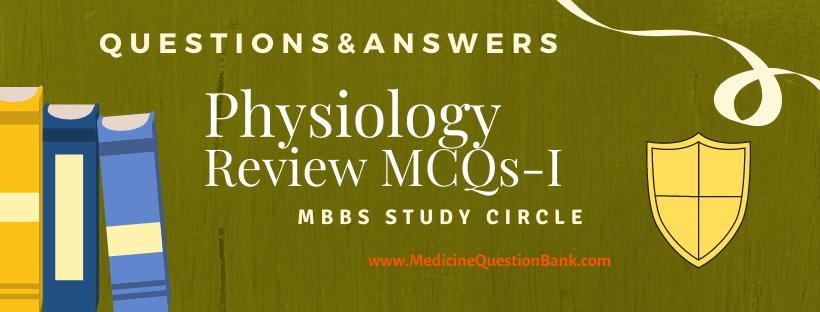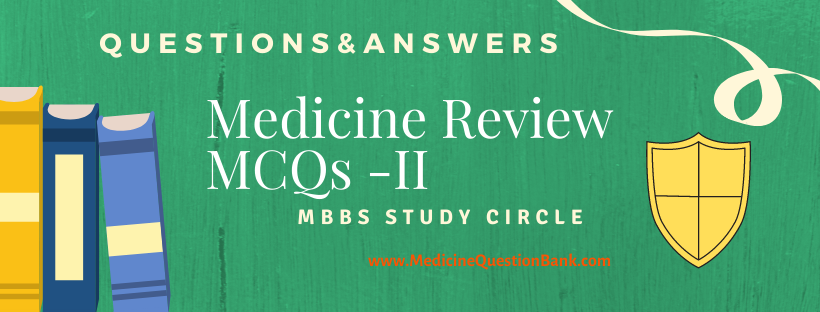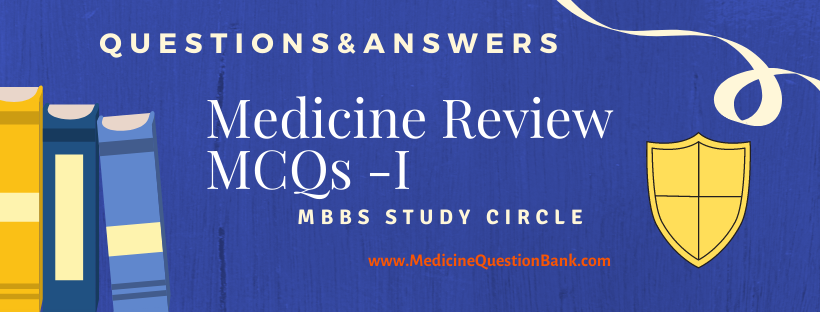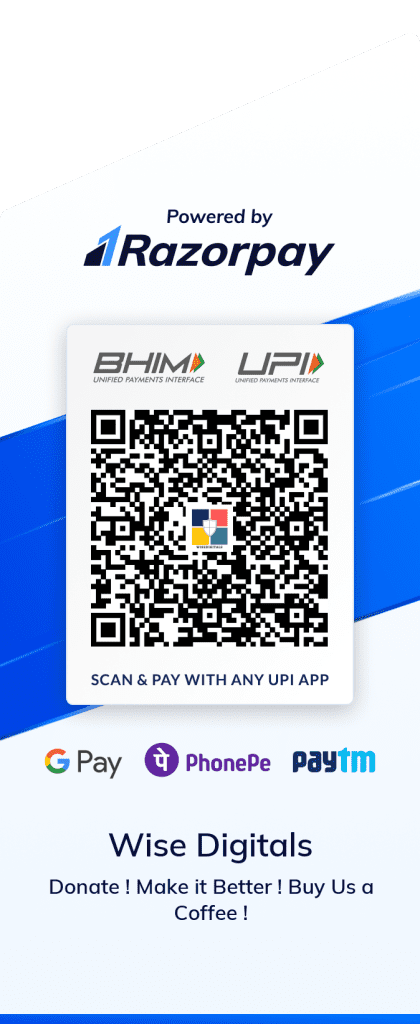Hypothalamo Pituitary Ovarian Axis
Contents1 True about Hypothalamo Pituitary Ovarian Axis is2 Most common group II ovulatory disorder is3...
Mitral Valve Anatomy
Contents1 Mechanical and metabolic balance of the valve is maintained by2 Mitral annulus is thinnest...
Carvallo’s sign
Contents1 Carvallo’s sign is a clinical sign found in patients with2 Following is TRUE about...
Ovarian Steroidogenesis
Contents1 Ovarian steroids are produced from all except2 Granulosa cells produce all except3 All are...
Anterior Pituitary gland in reproduction
Contents1 The pituitary gland is primarily derived from2 Not true of pituitary gland cells3 Which...
Dynamic outflow obstruction in HOCM
Contents1 Dynamic outflow obstruction in HOCM is due to2 Asymmetric left ventricular hypertrophy most commonly...
Light-near dissociation
Contents1 Pretectal lesions may be associated with any of 3 different patterns of pupillary deficit.2...
Collier’s sign
Contents1 Collier’s sign also known as –2 Collier’s sign is a medical sign of3 All of the...
Addison’s Plane
Anteriorly it passes through the tip of the 9th costal cartilage Posteriorly through the lower...
Image Question-23
Contents1 What is the diagnosis of Image?2 What is the diagnosis of histopathological slide?3 Gamna-Gandy...
Medicine Review MCQs-IX
Mycobacterium tuberculosis commonly infects -
Macrophages
Infected macrophages in the lung, through their production of chemokines, attract inactivated monocytes, lymphocytes, and neutrophils , none of which kill the bacteria very efficiently .
Granulomatous focal lesions composed of - macrophage-derived giant cells and lymphocytes begin to form.
Acid-fast microscopy may be reported based on the World Health Organization and International Union Against Tuberculosis and Lung Diseases (WHO-IUTLD) :
For the Ziehl-Neelsen Method (via light/brightfield microscopy)
More than 10 AFB per field in at least 20 visual fields -
The results of acid-fast microscopy may be reported based on the World Health Organization and International Union Against Tuberculosis and Lung Diseases (WHO-IUTLD):For the Ziehl-Neelsen Method (via light/brightfield microscopy)-
No Acid-fast bacilli (AFB) seen -
Report as "0". It means no AFB was observed in 2 lengths (i.e., 300 visual fields), thus, conferring a "negative" result.
1-9 AFB in 1 length - Record the actual number of AFB seen (e.g. +1, +2, +9). Note that the plus sign should precede the number. This is also referred to as a scanty positive result.
10-99 AFB in 1 length - Report as "1+". Note that the plus sign should come after the number. This is a positive result.
1-10 AFB per field in at least 50 visual fields - Report as "2+". Note that the plus sign should come after the number. This is a positive result.
More than 10 AFB per field in at least 20 visual fields - Report as "3+". Note that the plus sign should come after the number. This is a positive result and is highly infectious.
For Auramine Method (via fluorescence microscopy at 400x magnification) more than 60 AFB in 1 length - Report as
Microscopy of M. tuberculosis caseating granulomas revealed a type of cell that has a "horseshoe" pattern of nuclei. What is the name of that cell?
M. tuberculosis is characterized in tissue by caseating granulomas containing Langhans giant cells, which have a "horseshoe" pattern of nuclei.
Touton giant cells are seen in all of the following EXCEPT?
Touton giant cells are a type of multinucleated giant cell seen in lesions with high lipid content such as -
- fat necrosis,
- xanthoma,
- xanthelasma
- xanthogranulomas.
They are also found in dermatofibroma
What is the name of pointed Microscopic structure?
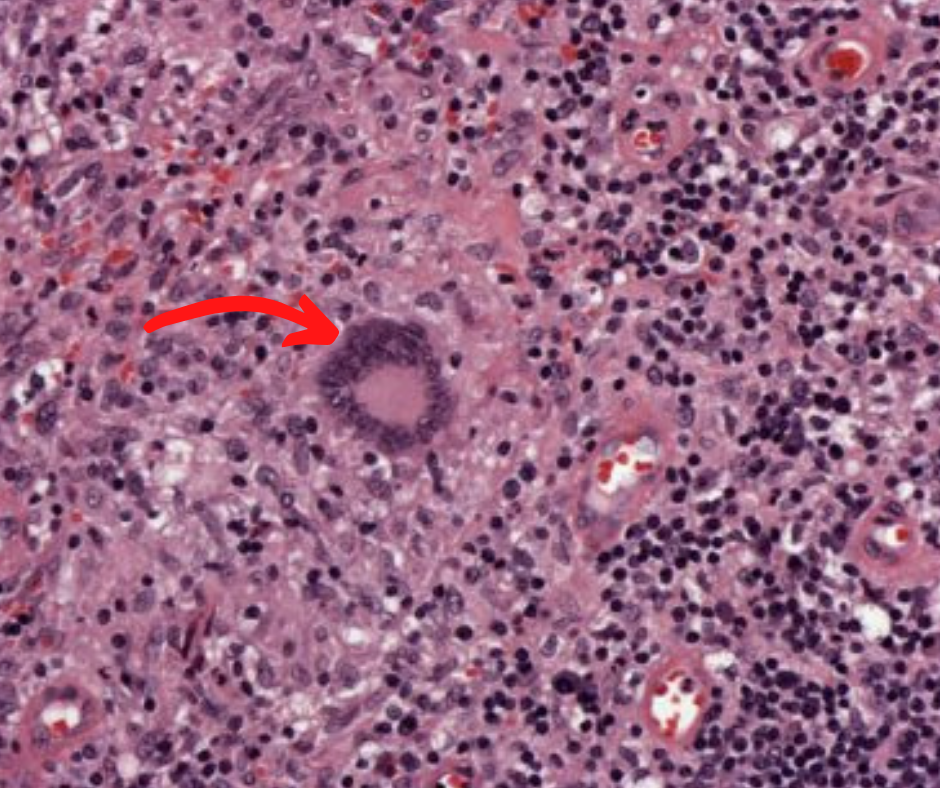
Diagnosis - Granulomatous lesion
Langhans giant cell
Autoantibodies against LRP4 have been seen in some cases of -
Myasthenia gravis is an autoimmune - T-cell-dependent disease.
Acetylcholine receptor (AChR) antibodies are found in approximately 80% of patients,
Other antibodies
Muscle-specific tyrosine kinase (Musk) antibodies [Anti-MUSK]
Low-Density Lipoprotein Receptor-Related Protein 4 (LRP4),
Agrin antibodies ,
Rapsyn antibodies ,
Striational antibodies
All of the following are LESS COMMON autoantibodies in Myasthenia Gravis EXCEPT -
The most common antibodies detected in MG are antibodies against acetylcholine receptors (AChRs), muscle-specific kinase (MuSK) and low-density lipoprotein receptor-related protein 4 (LRP4)
Additional antibodies of interest in MG are directed against agrin, titin, KV1.4, ryanodine receptors, collagen Q, and cortactin
Antibodies to cytolethal distending toxin B (CdtB) and vinculin are novel biomarkers that rule-in and differentiate irritable bowel syndrome with diarrhea (IBS-D) from other causes of diarrhea and healthy controls.
What % of patients with MG may present with prominent bulbar symptoms?
20% of patients in MG Shows Bulbar symptoms
All of the following auto-antibody seen in Graves' disease EXCEPT ?
Antibodies to glutamic acid decarboxylase (anti-GAD) are reliable serological markers of Type-1 Diabetes Mellitus.
Anti-GAD antibodies [high titre] are associated with the stiff-person syndrome (60% sensitivity),
Medicine Review MCQs-VIII
Most common cause of anemia is ---------
Most common cause of anemia is iron deficiency
Most common cause of iron deficiency in adults ------
Bleeding is the most common cause of iron deficiency in adults
Pagophagia is the compulsive consumption of ------------
Pagophagia is the compulsive consumption of ice or iced drinks
Pagophagia has been shown to be associated with iron-deficiency anemia and responsive to iron supplementation
Omophagia (omo - phagia): the act of eating raw meat.
Geophagia (geo - phagia): a term that refers to the eating of earth substances especially chalky or clay substances.
In healthy populations fingernails grow at about -----mm/day and toenails at about ----- mm/day
In healthy populations fingernails grow at about 0.1mm/day and toenails at about 0.05mm/day
Mees' lines appear after an episode of poisoning with -
1.Arsenic
2.Thallium
3.Selenium
Mees' lines appear after an episode of poisoning with arsenic thallium or other heavy metals or selenium
Prolonged use of -------------- can lead to blue-gray staining of skin, fingernails
Prolonged use of minocycline can lead to blue-gray staining of skin, fingernails, and scar tissue.
Muehrcke's lines - all of the following are TRUE EXCEPT-
Muehrcke's lines -
Pale transverse bands
Thumb is usually not involved - in contrast to Mees' lines
Not grooved - contrast to Beau's lines,
Half and half nails also called as -
Half and half nails ("Lindsay's nails")- proximal portion of the nail white and the distal half red, pink, or brown, with a sharp line of demarcation between the two halves
Half and Half nails were significantly common in -
Half and Half nails were significantly more common in hemodialysis patients,
leukonychia was significantly more common in renal transplant patients
Menkes disease - all of the following are CORRECT EXCEPT -
Hair appears strikingly peculiar: kinky, colorless or silvery, and brittle
Like all X-linked recessive conditions, Menkes disease is more common in males than in females.
Medicine Review MCQs-VII
Waddling gait also known as -
Myopathic gait also known as waddling gait is a form of gait abnormality.
The "waddling" is due to the weakness of the proximal muscles of the pelvic girdle
Waddling gait seen in all of the following EXCEPT -
Conditions associated with a myopathic gait -
pregnancy,
congenital hip dysplasia,
muscular dystrophies,
spinal muscular atrophy
Scissors gait seen in -
Knees and thighs hit or cross in a scissors-like pattern when walking
The steps are slow and small. This type of gait occurs often in patients with spastic cerebral palsy.
Steppage gait seen in -
“high stepping” type of gait in which the leg is lifted high, the foot drops, appearing floppy, and the toes points downward, scraping the ground, when walking.
HTT gene is located on the short arm (p) of chromosome ----------
Huntington's disease is a progressive brain disorder caused by a single defective gene on chromosome 4
Mutated HTT is the cause of Huntington's disease
Motor symptoms of Parkinsonism result from the death of cells in -
Parkinsonism - motor symptoms of the disease result from the death of cells in the substantia nigra
Wilson's disease gene (ATP7B) is on chromosome number ------
Wilson's disease - inherited in an autosomal recessive pattern
Wilson's disease gene (ATP7B) is on chromosome 13
Which disease is the most common from a group of hereditary diseases that cause copper overload in the liver?
Wilson's disease is the most common from a group of hereditary diseases that cause copper overload in the liver.
All can cause cirrhosis at a young age
Lactic acidosis is seen in deficiency of -
Pyruvate carboxylase deficiency - Lactic acidosis and Hyperammonaemia
Overexpression of superoxide dismutase-1[SOD1]has been linked to the neural disorders seen in -
SOD1 is located in the cytoplasm, SOD2 in the mitochondria, and SOD3 is extracellular.
Overexpression of SOD1 has been linked to the neural disorders seen in Down syndrome
Medicine Review MCQs-VI
Erythropoietin belongs to which of the following?
Glycoprotein hormone
Which is the major extra-renal site of Erythropoietin production?
Liver
Liver production predominates in the fetal and perinatal period
Renal production predominates in adulthood.
All of the following are CORRECT about Erythropoietin EXCEPT:
Half-life in blood around 5 h
We should consider administration of Erythropoiesis-stimulating agents when the Hb level becomes ---------- g/dl in dialysis patients.
We should consider administration of Erythropoiesis-stimulating agents when the Hb level becomes <10 g/dl in dialysis patients.
For patients on dialysis, ESAs should be initiated for an Hb <10 g/dL and the dose should be reduced or interrupted when the Hb level approaches or exceeds 11 g/dL
Most dialysis patients who are treated with ESAs, advised to maintain Hb levels between -------------
Pooled analysis of nine randomized control trials on patients with chronic kidney disease indicates that patients have higher mortality and morbidity from cardiovascular-related events when the hemoglobin falls below 10 g/dL.
There was no benefit in survival in patients treated with Erythropoiesis-stimulating agents when the hemoglobin exceeded 13 g/dL,
Target hemoglobin levels and optimal levels generally fall between 11 and 12 g/dL with the knowledge that higher doses of ESAs may increase the risk for thrombotic events.
In most dialysis patients who are treated with ESAs, we maintain Hb levels between 10 and 11.5 g/dL. We do not target an Hb concentration >13 g/dL. Our practice is consistent with the KDIGO 2012 guidelines
Anemia is defined by WHO as a hemoglobin (Hb) concentration ---------- for premenopausal females
Anemia is defined by WHO as a hemoglobin (Hb) concentration <13 g/dL for adult males and postmenopausal females and an Hb concentration <12 g/dL for premenopausal females
Longest half life of ESA -
Darbepoetin-α and methoxy polyethylene glycol-epoetin β (Continuous Erythropoietin Receptor Activator; CERA) were registered in 2010 and 2011 respectively, all for use during the predialytic phase of CKD.
Epoetin-α and -β are short-acting ESAs, and darbepoetin-α and CERA are long-acting ESAs.
Hemoglobin A- represents approximately ---------- of circulating hemoglobin.
Hemoglobin A- represents approximately 98% of circulating hemoglobin.
Reticulocyte hemoglobin concentration of less than ---------- support iron deficiency in the setting of inflammation
The challenge is the diagnosis of iron deficiency in the setting of the anemia of inflammation
Tests support iron deficiency in the setting of inflammation: a reticulocyte hemoglobin concentration of less than 28 pg
Which of the following is used as an iron replacement to prevent anemia in patients with chronic kidney disease who are on dialysis?
Ferric pyrophosphate citrate is used as an iron replacement to prevent anemia in patients with chronic kidney disease who are on dialysis.
Medicine Review MCQs-V
Oppositional paratonia also called as -
Oppositional paratonia - "gegenhalten" occurs when subjects involuntarily resist to passive movements, Facilitatory paratonia - "mitgehen" occurs when subjects involuntary assist passive movements.
Paratonia have been associated with cognitive impairment, particularly in relation to -
Paratonia have been associated with cognitive impairment or mental disorders, particularly in relation to frontal lobe dysfunction.
All of the following are seen in parkinsonism EXCEPT -
Coarse, slow tremor seen in Parkinsonism
All of the following are correct regarding tremor of Parkinsonism EXCEPT -
Disappears during voluntary movement
Typically appears in only one hand
It typically appears in only one hand, eventually affecting both hands as the disease progresses
Frequency of PD tremor is between 4 and 6 hertz
Reduced motivation or ability to experience pleasure is called -
Anhedonia is a diverse array of deficits in hedonic function, including reduced motivation or ability to experience pleasure
Alexithymia – a condition describing people who "lack words for their feelings
Avolition, as a symptom of various forms of psychopathology, is the decrease in the ability to initiate and persist in self-directed purposeful activities
The treatment of choice for Hashimoto thyroiditis -
Hashimoto’s thyroiditis -Treatment of choice for Hashimoto thyroiditis (or hypothyroidism from any cause) is thyroid hormone replacement.
The drug of choice is orally administered levothyroxine sodium.
Which is correct for Subclinical hypothyroidism?
Subclinical hypothyroidism suggests mild thyroid failure,
Evidenced by an elevated TSH above 4.0 μ IU/mL and normal free T4 levels
Hashimoto Thyroiditis rate of progression to overt hypothyroidism is estimated to be about ----- % per year.
The rate of progression to overt hypothyroidism is estimated to be about 5% per year.
Best marker of progression of Hashimoto Thyroiditis to overt hypothyroidism is -
Best marker of progression of Hashimoto Thyroiditis to overt hypothyroidism is a combination of an elevated TSH level with the presence of thyroid autoantibodies, namely anti-TPO and anti-Tg antibodies.
Hashimoto's disease affects more -------- sex and ---------- age group.
Hashimoto's disease affects more women than men.
Most often appears between ages 40 and 60.
Medicine Review MCQs-IV
Most common demyelinating disease -
Multiple sclerosis [encephalomyelitis disseminata] is the most common demyelinating disease.
Neuromyelitis optica - Devic's disease
In patients of porphyria predisposed to neurovisceral attacks all of the following can be a part of management EXCEPT-
Intravenous glucose,-terminate acute attacks through a reduction in δ-aminolaevulinic acid (ALA) synthetase activity, leading to reduced ALA and porphyrin synthesis.
Administration of haem (haematin or haem arginate) has been shown to reduce metabolite excretory rates, relieve pain and accelerate recovery.
Gonadotrophin-releasing hormone analogues - suppression of the menstrual cycle.
Exogenous oestrogens -Oral contraceptive pill is a common precipitating factor
Pseudohypoglycemia is an event during which the person with diabetes reports typical symptoms of hypoglycemia but has a measured glucose level
Pseudohypoglycemia is an event during which the person with diabetes reports typical symptoms of hypoglycemia but has a measured glucose level >70 mg/dL
Which is the first Physiologic response to hypoglycemia in normal subjects?
First defense- decrease in insulin secretion
glycemic threshold of 80 to 85 mg/dL
Second defense - increase in glucagon secretion
glycemic threshold for glucagon is 65 to 70 mg
Third defense - increase in epinephrine secretion
glycemic threshold for epinephrine secretion is also 65 to 70 mg/dL
Which is the first Physiologic response to hypoglycemia in patients with type 1 diabetes and longstanding type 2 diabetes. ?
First defense- to suppress insulin release, cannot occur in patients with absolute beta cell failure, ie, those with type 1 diabetes and longstanding type 2 diabetes.
Main defense against hypoglycemia is increased release of counter-regulatory hormones- glucagon and epinephrine, which raise plasma glucose concentrations by stimulating glucose production and by antagonizing the insulin-induced increase in glucose utilization.
Hypoglycemia causes neuronal death when glucose levels have fallen below ------- for some period.
Hypoglycemia causes neuronal death when glucose levels have fallen below 18 mg/dL for some period.
Impairment of action and judgment usually becomes obvious below -------- mg/dl
Impairment of action and judgment usually becomes obvious below 2.2 mmol/l (40 mg/dl).
As blood glucose levels fall below 0.55 mmol/l (10 mg/dl), most neurons become electrically silent and nonfunctional, resulting in coma.
Neuroglycopenia without hypoglycemia is called -
Hypoglycorrhachia is defined as an abnormally low glucose concentration within the cerebrospinal fluid is often suggestive of an underlying infectious or systemic process.
This is often defined as a glucose concentration less than 40 mg/dL.
Hypoglycorrhachia - Severe neuroglycopenic effects occurred despite normal blood glucose levels.
Symptomatic hypoglycemia occurring within four hours after a high carbohydrate meal is
Reactive hypoglycemia- is a term describing recurrent episodes of symptomatic hypoglycemia occurring within four hours after a high carbohydrate meal in people with and without diabetes.
In the US, hypoglycemia is when the blood glucose level is below ----- mg/dl within the first 24 hours of life and below ------ mg/dl thereafter
In the US, hypoglycemia is when the blood glucose level is below 30 mg/dl within the first 24 hours of life and below 45 mg/dl thereafter
Physiology Review MCQs -II
Serum has a higher concentration of -
Serum has a higher serotonin (5 hydroxytryptamine -SHT) content because of the breakdown of platelets during clotting
Total blood volume is ----- % of body weight
Total blood volume is 8 % of body weight
Prealbumin is a transport protein for -
Prealbumin is a transport protein for thyroid hormones
Thyroid hormone-binding proteins with highest binding affinities -
Thyroxine - Binding globulin - highest binding affinity
Albumin - Poorest binding affinity
Which of the following is used as the immunohistochemical marker for choroid plexus papillomas
Transthyretin
Diagnostically, transthyretin (TTR), KIR7.1, cytokeratin and Ki67 immunohistochemistry are most helpful
Which medicine is FDA approved for treatment of transthyretin amyloid cardiomyopathy?
Tafamidis has been FDA approved for treatment of transthyretin amyloid cardiomyopathy.
Patisiran and Inotersen have been approved by the FDA for treatment of polyneuropathy caused by hereditary transthyretin-mediated amyloidosis (hATTR) in adults.
Which NSAID have been shown to be inhibitors of transthyretin-related hereditary amyloidosis.
Diflunisal and several of its analogues have been shown to be inhibitors of transthyretin-related hereditary amyloidosis
Transthyretin is produced by all of the following EXCEPT-
Transthyretin is a protein that functions as a transporter of thyroxine and retinol and is produced chiefly by the liver (> 95%), with additional production within the choroid plexus of the brain and the retinal pigment epithelium.
Which of the following is mainly β-globulin?
Transferrin: α2- β globulin (mainly β -globulin),
Lipoprotein - α2-globulin plus lipid
Ceruloplasmin: α2- β globulin (mainly α2-globulin)
Haptoglobins: α2-globulin
In which order the proteins are regenerated after hemorrhage?
After haemorrhage - fibrinogen, globulin and albumin are regenerated in the same order
Medicine Review MCQs-III
Hypernatremia is defined as a serum sodium concentration of greater than -
Hypernatremia is defined as a serum sodium concentration of greater than 145 meq/l
All of the following Drugs Cause Nephrogenic Diabetes insipidus EXCEPT?
Nephrogenic DI occurs due to tubular unresponsiveness to the action of ADH. Can be inherited in an X-linked pattern Medications causing Nephrogenic DI- lithium, foscarnet, and demeclocycline
Demeclocyclin is used for treatment of -
Demeclocycline has been used in treatment of the syndrome of inappropriate antidiuretic hormone (ADH) secretion (SIADH), as it acts on collecting tubule cells to diminish their responsiveness to ADH, inducing nephrogenic diabetes insipidus.
Diabetes insipidus is defined as the passage of Large Urine volumes of urine with osmolality
Diabetes insipidus is defined as the passage of Urine volumes (>3 L/24 hr) of urine with osmolality(< 300 mOsm/kg).
Miller moses test done for-
Miller-Moses test -
Water deprivation (Miller-Moses) test to ensure adequate dehydration and maximal stimulation of ADH for diagnosis of Diabetes insipidus
Purpose of the test:
To measure how much urine is made and how concentrated it becomes when no water is given to a patient for a certain amount of time
Cerebral salt wasting occurs more frequently in which condition?
Aneurysmal subarachnoid hemorrhage
In hypernatremia the goal is to decrease the serum sodium by not more than -------- meq/L in 24 hours
Hypernatremia - The goal is to decrease the serum sodium by not more than 10 to 12 meq/L in 24 hours,
What is the maximum rate at which plasma osmolality can be corrected?
2 mOsm/kg/h.
What is the maximum rate at which sodium concentration can be corrected safely?
1 mEq/L/h
Acute hyponatremia should be treated without delay and rapidly at a rate of at least 1 mmol/L/hour, to prevent severe neurologic damage or death.
Severe symptoms are usually due to acute elevation of the plasma sodium concentration to above -
Severe symptoms are usually due to acute elevation of the plasma sodium concentration to above 157 mmol/L.
Values above 180 mmol/L are associated with a high mortality rate, particularly in adults.
what is the daily protein requirement for an adult?
1 g/kg per 24 hours
How many kcal in 1 g of carbohydrate?
4 kcal
Physiology Review MCQs-I
Nose filters particle greater than .-------- µm -
Small particles less than 10 micrometers in diameter pose the greatest problems, because they can get deep into your lungs, and some may even get into your bloodstream.
Nose offers about -------- % of resistance to airflow
Nose offers about 50% of resistance to airflow in the respiratory system.
Resistance to airflow in the nose
increases during viral infections
Volume of respiratory tract starting from nose to the ------- th generation airways is called anatomic dead space.
Volume of respiratory tract starting from nose to the generation-16 airways is called anatomic dead space
Which of the following is FALSE about cells in Alveoli ?
Type II cells are capable of cellular division, giving rise to more type I and II alveolar cells when the lung tissue is damaged.
Type II cells (granulous pneumocytes) in the alveolar wall contain secretory organelles known as lamellar bodies or lamellar granules, that fuse with the cell membranes and secrete pulmonary surfactant.
How the Particles with 2–10 µm in diameter are removed from lungs?
Particles less than 2 µm in diameter reach alveoli where
they are phagocytosed by alveolar macrophages.
Particles with 2–10 µm in diameter are generally
removed by conducting airways.
Particles
more than 10 µm in diameter are removed by hairs
in the nostrils.
Particles less than 2 µm in diameter reach alveoli where
they are phagocytosed by alveolar macrophages.
What will be the behaviour of Diaphragm of paralysed side during inspiration?
Diaphragm of paralysed side moves up rather than coming down during inspiration.
Bucket-handle effect is seen in which rib movement?
Pump-handle effect is exhibited by which ribs?
Pump-handle effect - Upper 4 ribs rotate the sternum in upward and
outward direction by a movement similar to handle of a water-pump .
This mainly increases the vertical diameter of thoracic cage [ anteroposterior diameter also
increases to some extent].
During Inspiration Intra pleural pressure becomes-
Intrapleural pressure (relative to atmospheric pressure) during expiration is about –2.5 to –4 mm Hg and during inspiration is about – 6 mm Hg
The volume of the air present in the lungs at the end of maximal inspiration -
Vital Capacity
The maximum volume of air that can be expired after a
maximal inspiratory effort
Forced Vital Capacity
The total volume of air that can be expired with greatest force and speed after a maximal inspiration
Inspiratory Capacity
This is the maximum volume of air that can be inspired after tidal expiration
Total Lung Capacity
The volume of the air present in the lungs at the end of maximal inspiration
Medicine Review MCQs- II
Creation of a “mastoid bowl” is done in the procedure for treatment of -
Cholesteatoma - creation of a “mastoid bowl” in which the ear canal and mastoid are joined into a large common cavity that must be periodically cleaned.
Schwartze procedure involves -
Schwartze procedure - Removal of Mastoid air cells is undertaken without affecting the middle ear. <br.This is typically done for mastoiditis
Suppurative otitis media, pain in the distribution of the trigeminal nerve, and abducens nerve palsy suggests -
Gradenigo syndrome
Triad of symptoms consisting of -
Periorbital unilateral pain related to trigeminal nerve involvement,
Diplopia due to sixth nerve palsy ,
Persistent otorrhea- associated with bacterial otitis media with apex involvement of the petrous part of the temporal bone (petrositis).
Empty delta sign in radiology seen in -
Empty delta sign is a radiologic sign seen on brain imaging which is associated with cerebral venous sinus thrombosis.
It is usually seen on magnetic resonance imaging (MRI) or computed tomography (CT) scans with contrast.
Sounds exceeding ------------- dB are potentially injurious to the cochlea -
Sounds exceeding 85 dB are potentially injurious to the cochlea, especially with prolonged exposures.
The loss typically begins in the high frequencies (especially 4000 Hz) and, with continuing exposure, progresses to involve the speech frequencies.
What is the Most Frequent cause of Sensory Hearing Loss ?
Presbyacusis is a progressive and irreversible bilateral symmetrical age-related sensorineural hearing loss resulting from degeneration of the cochlea or associated structures of the inner ear or auditory nerves.
The hearing loss is most marked at higher frequencies.
Antineoplastic agents most commonly associated with ototoxicity -
Antineoplastic agents most commonly associated with ototoxicity are the platinum-based compounds cisplatin and, to a lesser degree, carboplatin.
These agents are widely used in gynecologic, lung, central nervous system, head and neck, and testicular cancers
Steeple sign is suggestive of -
Steeple sign, also called the wine bottle sign,
Refers to the tapering of the upper trachea on a frontal chest radiograph reminiscent of a church steeple. The appearance is suggestive of croup
Holman-Miller sign seen in-
Holman-Miller sign (also called the antral sign) is seen in juvenile nasopharyngeal angiofibroma; it refers to the anterior bowing of the posterior wall of the maxillary antrum as seen on a lateral skull radiograph or cross-sectional imaging.
Juvenile nasopharyngeal angiofibroma (JNA) is a rare benign tumor arising predominantly in the nasopharynx of adolescent males. It is an aggressive neoplasm and shows a propensity for destructive local spread often extending to the base of the skull and into the cranium.
Phelp sign seen in -
Phelp sign - erosion of the caroticojugular spine between the carotid canal and jugular fossa
Medicine Review MCQs-I
What is the Incubation period of Staphylococcus aureus Food Poisoning ?
The incubation period for S. aureus food poisoning is between 2 and 4 hours (range 30 minutes to 8 hours)
5th June is known as -
UN designates 5 June as World Environment Day in 1972; two years later, the day is celebrated for the first time under the slogan “Only One Earth.”
1st December - World AIDS Day
1st July - Doctors Day
31st May No Tobacco Day
Salter’s scale used in which of the following condition?
SALTER SCALE -Spring hanging scale -
Used for taking weight of children under 9 years.
Weigh up to 25 kg
Graduated by 0.1kg (100g) increments.
Rule of Halves is seen in
rule of halves' for hypertension suggests -
-Half the population with hypertension are not known,
-Half of those known are not treated
-Half of those treated are not controlled.
Waist Hip Ratio indicates Obesity in Women when
Obesity is diagnosed when Waist Hip Ratio -
Women - >0.85,
Men > 1.00
WHR has been found to be a more efficient predictor of mortality in older people (>75 years of age) than waist circumference or BMI.
Evidence suggests that WHR is an accurate somatic indicator of reproductive endocrinological status and long-term health risk.
Which hepatitis virus carries highest risk of developing hepatocellular carcinoma as a complication?
Hepatitis B viral load is the strongest risk factor associated with an increased HCC risk, independent of HBeAg status and cirrhosis. Chronic inflammation caused by long-term exposure to high levels of HBV DNA will increase the risk of subsequent HCC.
Most common type of glomerulonephritis described in association with hepatitis B -
Three most common types of kidney disease resulting from HBV infection are:
●Membranous nephropathy
●Membranoproliferative glomerulonephritis (MPGN)
●Polyarteritis nodosa (PAN)
most common type of glomerulonephritis described in association with hepatitis B is membranous glomerulonephritis (MGN), found mainly in children. However, membranoproliferative glomerulonephritis (MPGN) and, even more rarely, immunoglobulin (Ig) A nephropathy, have also been identified.
What is the strongest risk factor associated with an increased HCC risk in HBV infection?
Hepatitis B viral load is the strongest risk factor associated with an increased HCC risk, independent of HBeAg status and cirrhosis. Chronic inflammation caused by long-term exposure to high levels of HBV DNA will increase the risk of subsequent HCC.
Anemia caused by a disorder of the porphyrin pathway leading to ineffective erythropoiesis is called -
In Sideroblastic anemias - affected erythroblasts, abnormal, iron-laden mitochondria appear to encircle the nucleus, giving rise to the defining morphological feature of sideroblastic anemias, the RING SIDEROBLAST
What is the type of cell in the image?
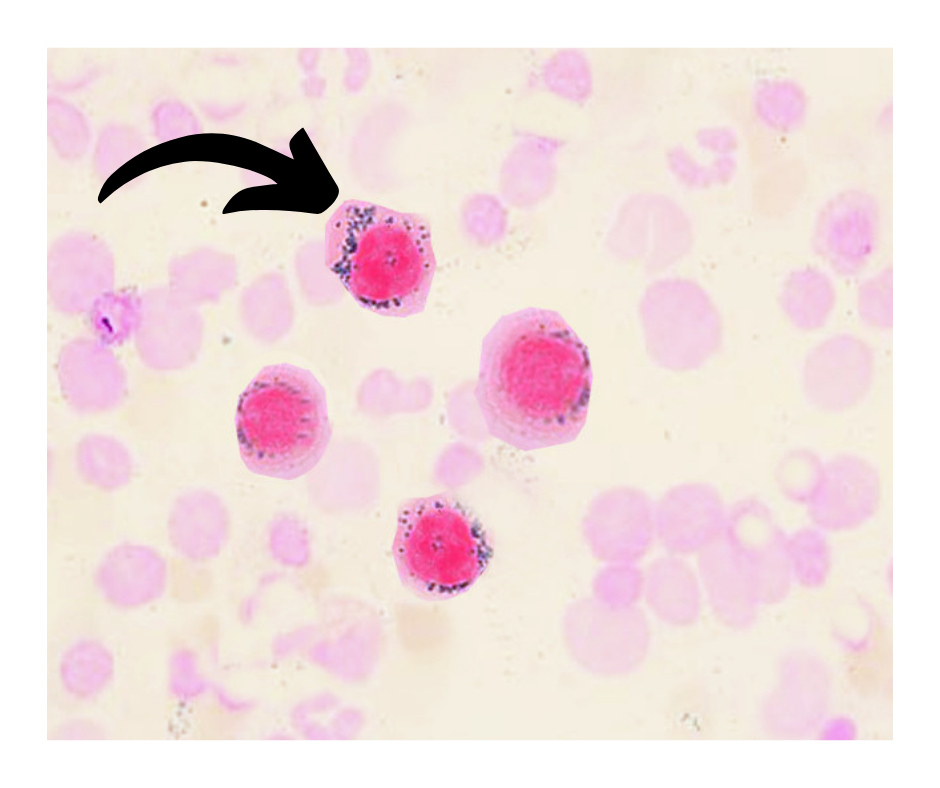
RING SIDEROBLAST
Feature of sideroblastic anemias, the RING SIDEROBLAST
What is the cell shown in Image?

Spur cells, or acanthocytes (from the Greek word acantha, "thorn"), are erythrocytes covered with spikelike projections.
They are characterized by diminished deformability, which is responsible for their entrapment and destruction in the spleen.
Acanthocytosis [spur cells] is associated with advanced liver disease, regardless of the primary cause
Alectinib, an anaplastic lymphokinase (ALK) inhibitor used for the treatment of non–small cell lung cancer, has been associated with spheroacanthocytosis without causing significant hemolytic anemia.
What are Echinocytes?
Echinocytes can be distinguished from acanthocytes by the shape of the projections, which are smaller and more numerous than in acanthocytes[Spur Cells] and are evenly spaced.
Echinocytes also exhibit central pallor.
Seen in conditions:
artifact of staining or drying, echinocytes are associated with:[5]
Uremia and chronic kidney disease
Liver disease
pyruvate kinase deficiency
hypophosphatemia
hyperlipidemia
Phosphoglycerate kinase deficiency
Disseminated malignancy
Myeloproliferative disorders
All of the following Causes Aquired sideroblastic anemis EXCEPT :
Acquired sideroblastic anemias-
Copper deficiency, which can occur as a part of -
Malabsorption,
Nephrotic syndrome - loss of ceruloplasmin
Gastric surgery - Decreased Copper Absorption
Which of the following can be a diagnosis in case of mostly showing small and medium-sized arteries vasculitis sparing pulmonary atreries ?
Polyarteritis nodosa - Small and Medium sized vessel vasculitis
Takayasu arteritis- Large vessels including aorta and arch branches,
Giant cell arteritis - Superficial temporal artery, other medium- and large-sized vessels Example - those supplying the head, eyes and optic nerves
Most common site of rash in SLE -
Red rash which is most commonly on the face
Medicine Review -I
Bronchoscopy: may demonstrate a ‘cobblestone’ appearance of the mucosa.
Bronchial and transbronchial biopsies usually show non-caseating granulomas.
HRCT: characteristic appearances include reticulonodular opacities that follow a perilymphatic distribution
Pulmonary Function Impairment
Renal Impairment.
Unexplained Dyspnea,
Restrictive Pattern On Pulmonary Function Tests
Elevated Hemidiaphragm.
Systemic Sclerosis,
Sjogren's Syndrome,
Rheumatoid Arthritis
para-aminosalicylic acid (PAS),
sulfasalazine,
imipramine,
chlorpropamide,
phenylbutazone
More Common In Men
Almost Exclusively In Smokers
Pathology - Glomerulonephritis and Pulmonary Haemorrhage.
—--------------------------
Pulmonary Infiltrates, Hypoxia and Haemoptysis
Commonly Precede Renal Involvement.
Miosis -constricted pupil
Partial ptosis,
Anhidrosis -Loss of hemifacial sweating
—--------------------------
Enophthalmos- sinking of the eyeball into the bony cavity that protects the eye.
Physiology Review -II
ADH,
neurophysin II ,
glycoprotein molecules.
transport the hormone from the cell body to the axon terminals
These are neurosecretory bodies or neurosecretory terminals.
Found in the posterior pituitary.
They represent the terminal end of the axons from the hypothalamus
Hormones are temporarily stored in these locations.
ADH causes water retention and brings osmolality back to normal. ADH secretion
Increased ECF volume,
Decreased temperature,
Ethanol,
Cortisol,
ANP,
Thyroxine
α-adrenergic agonist
All of above factors decrease ADH secretion.
Brain - Aquaporin 4
Salivary and Lacrimal glands and respiratory tract- Aquaporin 5
Human leucocytes -Aquaporin 9
polyuria and polydipsia.
Polyuria occurs due to ADH deficiency that promotes water diuresis. Polydipsia occurs secondary to dehydration caused by polyuria.
Diabetes mellitus- Urine is hyperosmolal due to loss of glucose in urine [>1200 mOsm/L]
Nephrogenic Diabetes Insipidus- kidneys fail to respond to ADH
Neurogenic Diabetes Insipidus- deficiency of ADH secretion .
Neurogenic DI is also called central DI
Rifampicin,
Aminoglycoside,
Lithium,
Cisplantin
Amphotericin B.
X-linked recessive defect -V2 receptor gene is deficient
Autosomal defect - aquaporin gene is deficient
desmopressin, chlorpropamide, high dose of oxytocin, vincrisitine, phenothiazine, carbamazepine
This escape phenomenon occurs due to down regulation of aquaporins production in collecting duct
Urine output increases despite high ADH levels in plasma
Cervical dilatation - at the time of parturition
1. milk ejection reflex
2. parturition reflex.
Mechanism-
uterus contracts severely in response to oxytocic and bleeding vessels are compressed in the contracted uterus that prevents bleeding.
Physiology Review -I
Endogenous production of insulin
Preproinsulin
Insulin Gene
A and B chains in Insulin
Clinical uses of C-peptide testing
Differential diagnosis of hypoglycemia.
possibility of gastrinomas associated with Multiple Endocrine Neoplasm syndromes (MEN 1).
determine degree of insulin resistance
Resources
Dashboard – Medicine Question Bank – FORUMMedicine Question Bank is 100% Free. Sign Up &…








